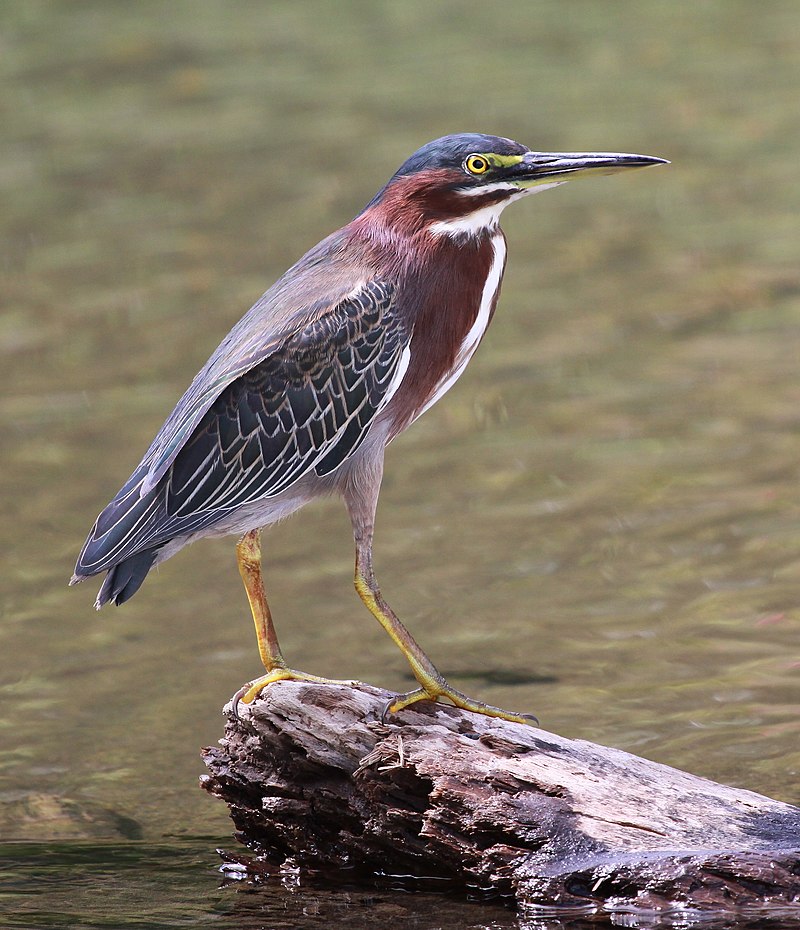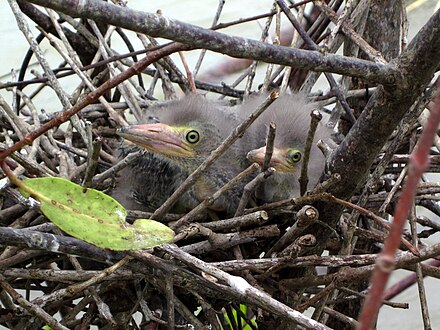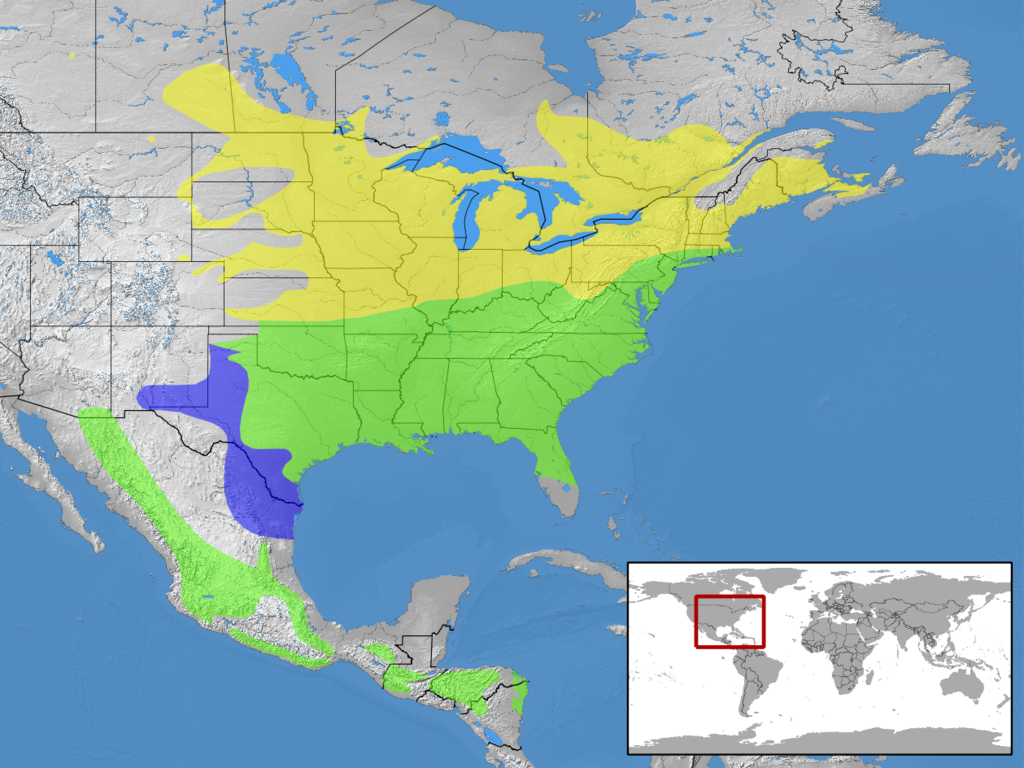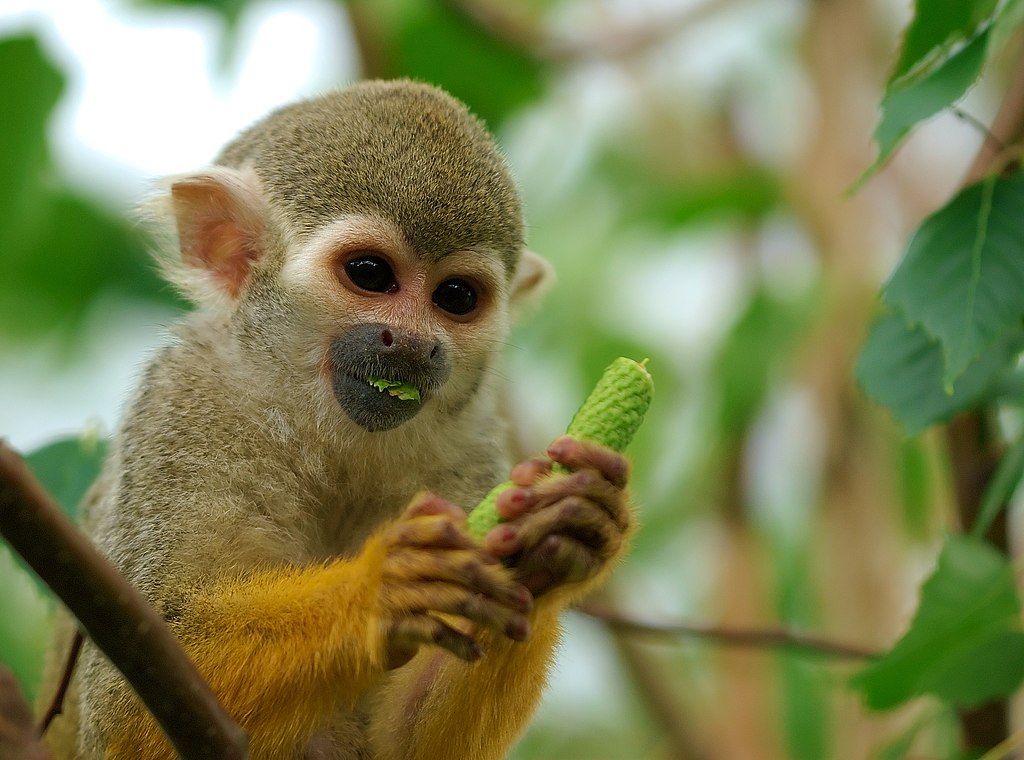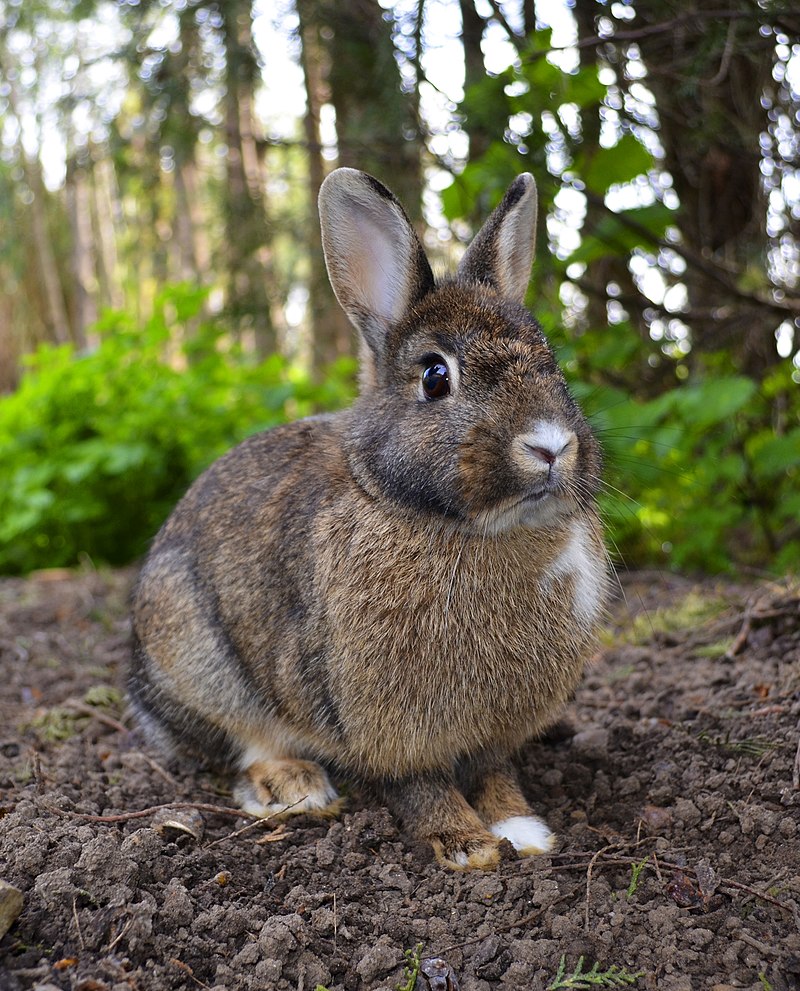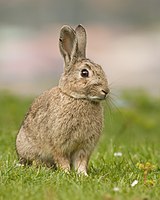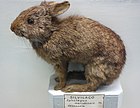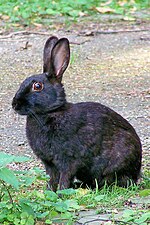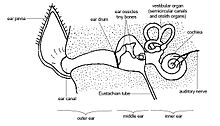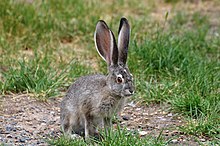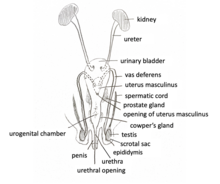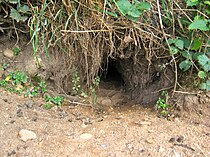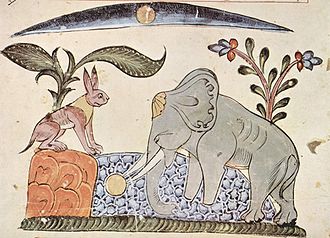Rabbits are small
mammals in the
family Leporidae of the
order Lagomorpha (along with the
hare and the
pika).
Oryctolagus cuniculus includes the
European rabbit species and its descendants, the world's
305 breeds[1] of
domestic rabbit.
Sylvilagus includes 13 wild rabbit species, among them the 7 types of
cottontail.
The European rabbit, which has been introduced on every continent
except Antarctica, is familiar throughout the world as a wild prey
animal and as a domesticated form of livestock and pet. With its
widespread effect on ecologies and cultures, the rabbit (or
bunny) is, in many areas of the world, a part of daily life—as food, clothing, a companion, and as a source of artistic inspiration.
Terminology
Male rabbits are called
bucks; females are called
does. An older term for an adult rabbit is
coney, while
rabbit once referred only to the young animals.
[2] Another term for a young rabbit is
bunny,
though this term is often applied informally (especially by children)
to rabbits generally, especially domestic ones. More recently, the term
kit or
kitten has been used to refer to a young rabbit.
A group of rabbits is known as a
colony or
nest (or, occasionally, a
warren, though this more commonly refers to where the rabbits live).
[3] A group of baby rabbits produced from a single mating is referred to as a
litter,
[4] and a group of domestic rabbits living together is sometimes called a
herd.
[5]
Taxonomy
Rabbits and hares were formerly classified in the order
Rodentia (rodent) until 1912, when they were moved into a new order,
Lagomorpha (which also includes
pikas). Below are some of the genera and species of the rabbit.
Brachylagus Idahoensis
Pygmy rabbit
Nesolagus netscheri
Sumatran Striped Rabbit
(Model)
Oryctolagus cuniculus
European rabbit
(Feral Tasmanian specimen)
Pentalagus furnessi
Amami rabbit
(Taxidermy specimen)
Romerolagus diazi
Volcano rabbit
(Taxidermy specimen)
Sylvilagus aquaticus
Swamp rabbit
(Juvenile)
Sylvilagus audubonii
Desert cottontail
Sylvilagus bachmani
Brush rabbit
Sylvilagus brasiliensis
Tapeti
(Taxidermy specimen)
Sylvilagus palustris
hefneri
Lower Keys
marsh rabbit
Order
Lagomorpha
Family
Leporidae
- Genus Brachylagus
- Genus Bunolagus
- Genus Lepus ← NOTE: This genus is considered a hare, not a rabbit
- Genus Nesolagus
- Genus Ochoronidae ← NOTE: This genus is considered a pika, not a rabbit
- Genus Oryctolagus
- Genus Pentalagus
- Genus Poelagus
- Genus Prolagidae ← NOTE: This genus is extinct.
- Genus Romerolagus
- Genus Sylvilagus
- Swamp rabbit, Sylvilagus aquaticus
- Desert cottontail, Sylvilagus audubonii
- Brush rabbit, Sylvilagus bachmani
- Forest rabbit, Sylvilagus brasiliensis
- Mexican cottontail, Sylvilagus cunicularis
- Dice's cottontail, Sylvilagus dicei
- Eastern cottontail, Sylvilagus floridanus
- Tres Marias rabbit, Sylvilagus graysoni
- Omilteme cottontail, Sylvilagus insonus
- San Jose brush rabbit, Sylvilagus mansuetus
- Mountain cottontail, Sylvilagus nuttallii
- Marsh rabbit, Sylvilagus palustris
- New England cottontail, Sylvilagus transitionalis
Differences from hares
Hares are
precocial, born relatively mature and mobile with hair and good vision, while rabbits are
altricial, born hairless and blind, and requiring closer care. Hares (and
cottontail rabbits) live a relatively solitary life in a simple nest above the ground, while most rabbits live in social groups underground in
burrows or warrens.
Hares are generally larger than rabbits, with ears that are more
elongated, and with hind legs that are larger and longer. Hares have not
been
domesticated, while descendants of the European rabbit are commonly bred as livestock and kept as pets.
Domestication
Rabbits have long been domesticated. Beginning in the
Middle Ages, the European rabbit has been widely kept as
livestock, starting in
ancient Rome.
Selective breeding has generated a
wide variety of rabbit breeds, many of which (since the early 19th century) are also kept as
pets. Some
strains of rabbit have been bred specifically as
research subjects.
As livestock, rabbits are bred for their
meat and
fur.
The earliest breeds were important sources of meat, and so became
larger than wild rabbits, but domestic rabbits in modern times range in
size from
dwarf to
giant. Rabbit fur, prized for its softness, can be found in a broad range of
coat colors and patterns, as well as lengths. The
Angora rabbit breed, for example, was developed for its long, silky fur, which is often
hand-spun into yarn. Other domestic rabbit breeds have been developed primarily for the commercial
fur trade, including the
Rex, which has a short
plush coat.
Biology
Evolution
Because the rabbit's
epiglottis is engaged over the soft palate except when swallowing, the rabbit is an
obligate nasal breather. Rabbits have two sets of incisor teeth, one behind the other. This way they can be distinguished from
rodents, with which they are often confused.
[6] Carl Linnaeus originally grouped rabbits and rodents under the class
Glires; later, they were separated as the scientific consensus is that many of their similarities were a result of
convergent evolution. However, recent DNA analysis and the discovery of a common ancestor has supported the view that they
do share a common lineage, and thus rabbits and rodents are now often referred to together as members of the superorder Glires.
[7]
Morphology
Since speed and agility are a rabbit's main defenses against predators
(including the swift fox), rabbits have large hind leg bones and well
developed musculature. Though
plantigrade at rest, rabbits are on their toes while running, assuming a more
digitigrade form. Rabbits use their strong claws for digging and (along with their teeth) for defense.
[8] Each front foot has four toes plus a
dewclaw. Each hind foot has four toes (but no dewclaw).
[9]
Melanistic coloring
Oryctologus cuniculus
European rabbit (wild)
Most wild rabbits (especially
compared to hares) have relatively full, egg-shaped bodies. The soft coat of the wild rabbit is
agouti in coloration (or, rarely,
melanistic), which aids in
camouflage. The tail of the rabbit (with the exception of the
cottontail species) is dark on top and white below. Cottontails have white on the top of their tails.
[10]
As a result of the position of the eyes in its skull, the rabbit
has a field of vision that encompasses nearly 360 degrees, with just a
small blind spot at the bridge of the nose.
[11]
Hind limb elements
This
image comes from a specimen in the Pacific Lutheran University natural
history collection. It displays all of the skeletal articulations of
rabbit's hind limbs.
The anatomy of rabbits' hind limbs are structurally similar to that
of other land mammals and contribute to their specialized form of
locomotion. The Bones of the hind limbs consist of long bones (the
femur, tibia, fibula, and phalanges) as well as short bones (the
tarsals). These bones are created through
endochondral ossification during development.
[12]
Like most land mammals, the round head of the femur articulates with
the acetabulum of the ox coxae. The femur articulates with the tibia,
but not the fibula, which is fused to the tibia. The tibia and fibula
articulate with the tarsals of the pes, commonly called the foot. The
hind limbs of the rabbit are longer than the front limbs. This allows
them to produce their hopping form of locomotion. Longer hind limbs are
more capable of producing faster speeds.
Hares, which have longer legs than
cottontail rabbits, are able to move considerably faster.
[13] Rabbits stay just on their toes when moving this is called
Digitigrade locomotion. The hind feet have four long toes that allow for this and are webbed to prevent them from spreading when hopping.
[14]
Rabbits do not have paw pads on their feet like most other animals that
use digitigrade locomotion. Instead, they have coarse compressed hair
that offers protection.
[15]
Musculature
The rabbits hind limb (lateral view) includes muscles involved in the quadriceps and hamstrings.
Rabbits have muscled hind legs that allow for maximum force,
maneuverability, and acceleration that is divided into three main parts;
foot, thigh, and leg. The hind limbs of a rabbit are an exaggerated
feature, that are much longer than the forelimbs providing more force.
Rabbits run on their toes to gain the optimal stride during locomotion.
The force put out by the hind limbs is contributed to both the
structural anatomy of the fusion tibia and fibula, and muscular
features.
[16]
Bone formation and removal, from a cellular standpoint, is directly
correlated to hind limb muscles. Action pressure from muscles creates
force that is then distributed through the skeletal structures. Rabbits
that generate less force, putting less stress on bones are more prone to
osteoporosis due to bone
rarefaction.
[17] In rabbits, the more fibers in a muscle, the more resistant to fatigue. For example,
hares have a greater resistant to fatigue than
cottontails. The muscles of rabbit's hind limbs can be classified into four main categories:
hamstrings,
quadriceps,
dorsiflexors, or
plantar flexors.
The quadriceps muscles are in charge of force production when jumping.
Complimenting these muscles are the hamstrings which aid in short bursts
of action. These muscles play off of one another in the same way as the
plantar flexors and doriflexors, contributing to the generation and
actions associated with force.
[18]
Ears
Within the order
lagomorphs, the ears are utilized to detect and avoid predators. In the family
leporidae, the ears are typically longer than they are wide. For example, in
black tailed jack rabbits,
their long ears cover a greater surface area relative to their body
size that allow them to detect predators from far away. Contrasted to
cotton tailed rabbits, their ears are smaller and shorter, requiring
predators to be closer to detect them before fleeing. Evolution has
favored rabbits to have shorter ears so the larger surface area does not
cause them to lose heat in more temperate regions. The opposite can be
seen in rabbits that live in hotter climates, mainly because they
possess longer ears that have a larger surface area that help with
dispersion of heat as well as the theory that sound does not travel well
in more arid air, opposed to cooler air. Therefore, longer ears are
meant to aid the organism in detecting prey sooner rather than later in
warmer temperatures.
[19] The rabbit is characterized by its shorter ears while hares are characterized by their longer ears.
[20] Rabbits' ears are an important structure to aid
thermoregulation
and detect predators due to how the outer, middle, and inner ear
muscles coordinate with one another. The ear muscles also aid in
maintaining balance and movement when fleeing predators.
[21]
Outer ear
The
Auricle (anatomy), also known as the pinna is a rabbit's outer ear.
[22]
The rabbit's body surface is mainly taken up by the pinnae. It is
theorized that the ears aid in dispersion of heat at temperatures above
30 °C with rabbits in warmer climates having longer pinnae due to this.
Another theory is that the ears function as shock absorbers that could
aid and stabilize rabbit's vision when fleeing predators, but this has
typically only been seen in hares.
[23] The rest of the outer ear has bent canals that lead to the
eardrum or
tympanic membrane.
[24]
Middle ear
The middle ear is filled with three bones called
ossicles
and is separated by the outer eardrum in the back of the rabbit's
skull.The three ossicles are called hammer, anvil, and stirrup and act
to decrease sound before it hits the inner ear. In general, the ossicles
act as a barrier to the inner ear for sound energy.
[24]
Inner ear
Inner ear fluid called
endolymph receives the sound energy. After receiving the energy, later within the inner ear there are two parts: the
cochlea that utilizes sound waves from the ossicles and the
vestibular apparatus that manages the rabbit's position in regards to movement. Within the cochlea there is a
basilar membrane
that contains sensory hair structures utilized to send nerve signals to
the brain so it can recognize different sound frequencies. Within the
vestibular apparatus the rabbit possesses three semicircular canals to
help detect
angular motion.
[24]
Thermoregulation
Thermoregulation is the process that an organism utilizes to maintain an optimal body temperature independent of external conditions.
[25]
This process is carried out by the pinnae which takes up most of the
rabbit's body surface and contain a vascular network and arteriovenous
shunts.
[26] In a rabbit, the optimal body temperature is around 38.5–40℃.
[27] If their body temperature exceeds or does not meet this optimal temperature, the rabbit must return to
homeostasis.
Homeostasis of body temperature is maintained by the use of their
large, highly vascularized ears that are able to change the amount of
blood flow that passes through the ears.
Rabbits use their large vascularized ears which aid in thermoregulation to keep their body temperature at an optimal level.
Constriction and dilation of blood vessels in the ears are used to
control the core body temperature of a rabbit. If the core temperature
exceeds its optimal temperature greatly, blood flow is constricted to
limit the amount of blood going through the vessels. With this
constriction, there is only a limited amount of blood that is passing
through the ears where ambient heat would be able to heat the blood that
is flowing through the ears and therefore, increasing the body
temperature. Constriction is also used when the ambient temperature is
much lower than that of the rabbit's core body temperature. When the
ears are constricted it again limits blood flow through the ears to
conserve the optimal body temperature of the rabbit. If the ambient
temperature is either 15 degrees above or below the optimal body
temperature, the blood vessels will dilate. With the blood vessels being
enlarged, the blood is able to pass through the large surface area
which causes it to either heat or cool down.
During the summer, the rabbit has the capability to stretch its
pinnae which allows for greater surface area and increase heat
dissipation. In the winter, the rabbit does the opposite and folds its
ears in order to decrease its surface area to the ambient air which
would decrease their body temperature.
Respiratory System
The rabbit's nasal cavity lies dorsal to the oral cavity, and the two compartments are separated by the hard and soft palate.
[28]
The nasal cavity itself is separated into a left and right side by a
cartilage barrier, and it is covered in fine hairs that trap dust before
it can enter the respiratory tract.
[29][28]
As the rabbit breathes, air flows in through the nostrils along the
alar folds. From there, the air moves into the nasal cavity, also known
as the nasopharynx, down through the trachea, through the larynx, and
into the lungs.
[29][30] The larynx functions as the rabbit's voice box, which enables it to produce a wide variety of sounds.
[29]
The trachea is a long tube embedded with cartilaginous rings that
prevent the tube from collapsing as air moves in and out of the lungs.
The trachea then splits into a left and right bronchus, which meet the
lungs at a structure called the
hilum.
From there, the bronchi split into progressively more narrow and
numerous branches. The bronchi branch into bronchioles, into respiratory
bronchioles, and ultimately terminate at the alveolar ducts. The
branching that is typically found in rabbit lungs is a clear example of
monopodial branching, in which smaller branches divide out laterally
from a larger central branch.
[31]
Rabbits breathe primarily through their noses due to the fact
that the epiglottis is fixed to the backmost portion of the soft palate.
[30]
Within the oral cavity, a layer of tissue sits over the opening of the
glottis, which blocks airflow from the oral cavity to the trachea.
[28]
The epiglottis functions to prevent the rabbit from aspirating on its
food. Further, the presence of a soft and hard palate allow the rabbit
to breathe through its nose while it feeds.
[29]
Monopodial branching as seen in dissected rabbit lungs.
Rabbits lungs are divided into four lobes: the cranial, middle,
caudal, and accessory lobes. The right lung is made up of all four
lobes, while the left lung only has two: the cranial and caudal lobes.
[31] In order to provide space for the heart, the left cranial lobe of the lungs is significantly smaller than that of the right.
[28] The diaphragm is a muscular structure that lies caudal to the lungs and contracts to facilitate respiration.
[28][30]
Digestion
Rabbits are
herbivores that feed by grazing on
grass,
forbs, and leafy weeds. In consequence, their diet contains large amounts of
cellulose, which is hard to digest. Rabbits solve this problem via a form of
hindgut fermentation. They pass two distinct types of feces: hard droppings and soft black viscous pellets, the latter of which are known as
caecotrophs or "night droppings"
[32] and are immediately eaten (a behaviour known as
coprophagy). Rabbits reingest their own droppings (rather than
chewing the cud as do cows and numerous other herbivores) to digest their food further and extract sufficient nutrients.
[33]
Rabbits graze heavily and rapidly for roughly the first half-hour
of a grazing period (usually in the late afternoon), followed by about
half an hour of more selective feeding.
[citation needed] In this time, the rabbit will also excrete many hard fecal pellets, being waste pellets that will not be reingested.
[citation needed] If the environment is relatively non-threatening, the rabbit will remain outdoors for many hours, grazing at intervals.
[citation needed]
While out of the burrow, the rabbit will occasionally reingest its
soft, partially digested pellets; this is rarely observed, since the
pellets are reingested as they are produced.
[citation needed]
Video of a wild European rabbit with ears twitching and a jump
Hard pellets are made up of hay-like fragments of plant cuticle and
stalk, being the final waste product after redigestion of soft pellets.
These are only released outside the burrow and are not reingested. Soft
pellets are usually produced several hours after grazing, after the hard
pellets have all been excreted.
[citation needed] They are made up of micro-organisms and undigested plant cell walls.
[citation needed]
Rabbits are
hindgut digesters. This means that most of their digestion takes place in their
large intestine and
cecum.
In rabbits, the cecum is about 10 times bigger than the stomach and it
along with the large intestine makes up roughly 40% of the rabbit's
digestive tract.
[34]
The unique musculature of the cecum allows the intestinal tract of the
rabbit to separate fibrous material from more digestible material; the
fibrous material is passed as feces, while the more nutritious material
is encased in a mucous lining as a
cecotrope. Cecotropes, sometimes called "night feces", are high in
minerals,
vitamins and
proteins
that are necessary to the rabbit's health. Rabbits eat these to meet
their nutritional requirements; the mucous coating allows the nutrients
to pass through the acidic stomach for digestion in the intestines. This
process allows rabbits to extract the necessary nutrients from their
food.
[35]
The chewed plant material collects in the large cecum, a
secondary chamber between the large and small intestine containing large
quantities of symbiotic bacteria that help with the digestion of
cellulose and also produce certain B vitamins. The pellets are about 56%
bacteria by dry weight, largely accounting for the pellets being 24.4%
protein on average. The soft feces form here and contain up to five
times the vitamins of hard feces. After being excreted, they are eaten
whole by the rabbit and redigested in a special part of the stomach. The
pellets remain intact for up to six hours in the stomach; the bacteria
within continue to digest the plant carbohydrates. This double-digestion
process enables rabbits to use nutrients that they may have missed
during the first passage through the gut, as well as the nutrients
formed by the microbial activity and thus ensures that maximum nutrition
is derived from the food they eat.
[10] This process serves the same purpose in the rabbit as
rumination does in cattle and sheep.
[36]
Rabbits are incapable of
vomiting.
[37] Because rabbits can't vomit, if buildup occurs within the intestines (due often to a diet with insufficient fiber
[38]), intestinal blockage can occur.
[39]
Reproduction
Diagram of the male rabbit reproductive system with main components labeled.
The adult male reproductive system forms the same as most mammals with the seminiferous tubular compartment containing the
Sertoli cells and an adluminal compartment that contains the
Leydig cells[40]. The Leydig cells produce
testosterone, which maintains libido
[40] and creates secondary sex characteristics such as the
genital tubercle and
penis. The Sertoli cells triggers the production of
Anti-Mullerian duct hormone,
which absorbs the mullerian duct. In an adult male rabbit, the sheath
of the penis is cylinder-like and can be extruded as early as 2 months
of age
[41]. The scrotal sacs lay lateral to the penis and contain
epididymal
fat pads which protect the testes. Between 10-14 weeks, the testes
descend and are able to retract into the pelvic cavity in order to
thermoregulate
[41].
Furthermore, the secondary sex characteristics, such as the testes, are
complex and secrete many compounds. These compounds includes
fructose,
citric acid,
minerals, and a uniquely high amount of
catalase[40].
Diagram of the female rabbit reproductive system with main components labeled.
The adult female reproductive tract is
bipartite, which prevents an embryo from translocating
between uteri
[42]. The two uterine horns communicate to two cervixes and forms one
vaginal canal. Along with being bipartite, the female rabbit does not go through an
estrus cycle, which causes mating induced ovulation
[41].
The average female rabbit becomes sexually mature at 3 to 8
months of age and can conceive at any time of the year for the duration
of her life. However, egg and sperm production can begin to decline
after three years.
[40]
During mating, the male rabbit will mount the female rabbit from behind
and insert his penis into the female and make rapid pelvic hip thrusts.
The encounter lasts only 20-40 seconds and after, the male will throw
himself backwards off of the female.
[43]
The rabbit
gestation
period is short and ranges from 28 to 36 days with an average period of
31 days. A longer gestation period will generally yield a smaller
litter while shorter gestation periods will give birth to a larger
litter. The size of a single litter can range from four to 12 kits
allowing a female to deliver up to 60 new kits a year. After birth, the
female can become pregnant again as early as the next day.
[41]
The mortality rates of embryos are high in rabbits and can be due
to infection, trauma, poor nutrition and environmental stress so a high
fertility rate is necessary to counter this.
[41]
Sleep
Rabbits may appear to be
crepuscular, but their natural inclination is toward
nocturnal activity.
[44] In 2011, the average sleep time of a rabbit in captivity was calculated at 8.4 hours per day.
[45] As with other
prey animals, rabbits often sleep with their eyes open, so that sudden movements will awaken the rabbit to respond to potential danger.
[46]
Diseases
In addition to being at risk of disease from common pathogens such as
Bordetella bronchiseptica and
Escherichia coli, rabbits can contract the virulent, species-specific viruses
RHD ("rabbit hemorrhagic disease", a form of calicivirus)
[47] or
myxomatosis. Among the parasites that infect rabbits are tapeworms (such as
Taenia serialis), external parasites (including fleas and mites), coccidia species, and
Toxoplasma gondii.
[48][49]
Domesticated rabbits with a diet lacking in high fiber sources, such as
hay and grass, are susceptible to potentially lethal gastrointestinal
stasis.
[50] Rabbits and hares are almost never found to be infected with rabies and have not been known to transmit rabies to humans.
[51]
Encephalitozoon cuniculi, an obligate intracellular parasite is also capable of infecting many mammals including rabbits.
Ecology
Rabbit kits
(one hour after birth)
Rabbits are
prey
animals and are therefore constantly aware of their surroundings. For
instance, in Mediterranean Europe, rabbits are the main prey of red
foxes, badgers, and Iberian lynxes.
[52]
If confronted by a potential threat, a rabbit may freeze and observe
then warn others in the warren with powerful thumps on the ground.
Rabbits have a remarkably wide field of vision, and a good deal of it is
devoted to overhead scanning.
[53]
They survive predation by burrowing, hopping away in a zig-zag motion,
and, if captured, delivering powerful kicks with their hind legs. Their
strong teeth allow them to eat and to bite in order to escape a
struggle.
[54] The longest-lived rabbit on record, a domesticated
European rabbit living in
Tasmania, died at age 18.
[55] The lifespan of wild rabbits is much shorter; the average longevity of an
eastern cottontail, for instance, is less than one year.
[56]
Habitat and range
Rabbit habitats include
meadows,
woods,
forests,
grasslands,
deserts and
wetlands.
[57] Rabbits live in groups, and the best known species, the
European rabbit, lives in underground
burrows, or rabbit holes. A group of burrows is called a
warren.
[57]
More than half the world's rabbit population resides in
North America.
[57] They are also native to southwestern Europe,
Southeast Asia,
Sumatra, some islands of
Japan, and in parts of
Africa and
South America. They are not naturally found in most of
Eurasia, where a number of species of
hares are present. Rabbits first entered South America relatively recently, as part of the
Great American Interchange. Much of the continent has just one species of rabbit, the
tapeti, while most of South America's
southern cone is without rabbits.
The European rabbit has been introduced to many places around the world.
[10]
Environmental problems
Rabbits have been a source of environmental problems when introduced
into the wild by humans. As a result of their appetites, and the rate at
which they breed,
feral rabbit depredation can be problematic for agriculture.
Gassing,
barriers (fences), shooting, snaring, and
ferreting have been used to control rabbit populations, but the most effective measures are diseases such as
myxomatosis (
myxo or
mixi, colloquially) and
calicivirus. In Europe, where rabbits are farmed on a large scale, they are protected against myxomatosis and calicivirus with a
genetically modified virus.
The virus was developed in Spain, and is beneficial to rabbit farmers.
If it were to make its way into wild populations in areas such as
Australia, it could create a population boom, as those diseases are the
most serious threats to rabbit survival. Rabbits in Australia and New
Zealand are considered to be such a pest that land owners are legally
obliged to control them.
[58][59]
As food and clothing
Saint Jerome in the Desert
[Note rabbit being chased by a (trained?) domesticated hound]
Taddeo Crivelli (Italian, died about 1479)
In some areas, wild rabbits and hares are hunted for their meat, a lean source of high quality protein.
[60] In the wild, such hunting is accomplished with the aid of trained
falcons,
ferrets, or
dogs, as well as with
snares or other traps, and
rifles. A caught rabbit may be dispatched with a sharp blow to the back of its head, a practice from which the term
rabbit punch is derived.
Wild leporids comprise a small portion of global rabbit-meat consumption. Domesticated descendants of the European rabbit
(Oryctolagus cuniculus) that are bred and kept as livestock (a practice called
cuniculture) account for the estimated 200 million tons of rabbit meat produced annually.
[61] In 1994, the countries with the highest consumption per capita of rabbit meat were
Malta with 8.89 kilograms (19.6 lb),
Italy with 5.71 kilograms (12.6 lb), and
Cyprus with 4.37 kilograms (9.6 lb), falling to 0.03 kilograms (0.066 lb) in
Japan.
The figure for the United States was 0.14 kilograms (0.31 lb) per
capita. The largest producers of rabbit meat in 1994 were China, Russia,
Italy, France, and Spain.
[62] Rabbit meat was once a common commodity in
Sydney, Australia, but declined after the
myxomatosis virus was intentionally introduced to control the exploding population of
feral rabbits in the area.
In the United Kingdom, fresh rabbit is sold in butcher shops and
markets, and some supermarkets sell frozen rabbit meat. At farmers
markets there, including the famous
Borough Market in London, rabbit carcasses are sometimes displayed hanging, unbutchered (in the traditional style), next to braces of
pheasant or other small game. Rabbit meat is a feature of Moroccan cuisine, where it is cooked in a
tajine with "raisins and grilled almonds added a few minutes before serving".
[63] In China, rabbit meat is particularly popular in
Sichuan cuisine, with its stewed rabbit, spicy diced rabbit, BBQ-style rabbit, and even spicy rabbit heads, which have been compared to
spicy duck neck.
[61] Rabbit meat is comparatively unpopular elsewhere in the Asia-Pacific.
An extremely rare infection associated with rabbits-as-food is
tularemia (also known as
rabbit fever), which may be contracted from an infected rabbit.
[64]
Hunters are at higher risk for tularemia because of the potential for
inhaling the bacteria during the skinning process. An even more rare
condition is
protein poisoning,
which was first noted as a consequence of eating rabbit meat to
exclusion (hence the colloquial term, "rabbit starvation"). Protein
poisoning, which is associated with extreme conditions of the total
absence of dietary fat and protein, was noted by
Vilhjalmur Stefansson in the late 19th century and in the journals of
Charles Darwin.
In addition to their meat, rabbits are used for their
wool,
fur, and
pelts, as well as their nitrogen-rich manure and their high-protein milk.
[65] Production industries have developed domesticated rabbit breeds (such as the well-known
Angora rabbit) to efficiently fill these needs.
In art, literature, and culture
Rabbits are often used as a symbol of
fertility or rebirth, and have long been associated with
spring and
Easter as the
Easter Bunny.
The species' role as a prey animal with few defenses evokes
vulnerability and innocence, and in folklore and modern children's
stories, rabbits often appear as sympathetic characters, able to connect
easily with youth of all kinds (for example, the
Velveteen Rabbit, or
Thumper in
Bambi).
With its reputation as a prolific breeder, the rabbit juxtaposes
sexuality with innocence, as in the
Playboy Bunny.
The rabbit (as a swift prey animal) is also known for its speed,
agility, and endurance, symbolized (for example) by the marketing icons
the
Energizer Bunny and the
Duracell Bunny.
Folklore and mythology
The rabbit often appears in folklore as the
trickster archetype, as he uses his cunning to outwit his enemies.
"Rabbit fools Elephant by showing the reflection of the moon".
Illustration (from 1354) of the Panchatantra
- In Aztec mythology, a pantheon of four hundred rabbit gods known as Centzon Totochtin, led by Ometotchtli or Two Rabbit, represented fertility, parties, and drunkenness.
- In Central Africa, the common hare (Kalulu), is "inevitably described" as a trickster figure.[66]
- In Chinese folklore, rabbits accompany Chang'e on the Moon. In the Chinese New Year, the zodiacal rabbit is one of the twelve celestial animals in the Chinese zodiac. Note that the Vietnamese zodiac includes a zodiacal cat in place of the rabbit, possibly because rabbits did not inhabit Vietnam.[citation needed] The most common explanation, however, is that the ancient Vietnamese word for "rabbit" (mao) sounds like the Chinese word for "cat" (卯, mao).[67]
- In Japanese tradition, rabbits live on the Moon where they make mochi, the popular snack of mashed sticky rice.
This comes from interpreting the pattern of dark patches on the moon as
a rabbit standing on tiptoes on the left pounding on an usu, a Japanese mortar.
- In Jewish folklore, rabbits (shfanim שפנים) are associated with cowardice, a usage still current in contemporary Israeli spoken Hebrew (similar to the English colloquial use of "chicken" to denote cowardice).
- In Korean mythology, as in Japanese, rabbits live on the moon making rice cakes ("Tteok" in Korean).
- In Anishinaabe traditional beliefs, held by the Ojibwe and some other Native American peoples, Nanabozho, or Great Rabbit, is an important deity related to the creation of the world.
- A Vietnamese
mythological story portrays the rabbit of innocence and youthfulness.
The Gods of the myth are shown to be hunting and killing rabbits to show
off their power.
- Buddhism, Christianity, and Judaism have associations with an ancient circular motif called the three rabbits (or "three hares"). Its meaning ranges from "peace and tranquility", to purity or the Holy Trinity, to Kabbalistic levels of the soul or to the Jewish diaspora. The tripartite symbol also appears in heraldry and even tattoos.
The rabbit as
trickster is a part of American popular culture, as
Br'er Rabbit (from African-American folktales and, later,
Disney animation) and
Bugs Bunny (the
cartoon character from
Warner Bros.), for example.
Anthropomorphized rabbits have appeared in film and literature, in
Alice's Adventures in Wonderland (the
White Rabbit and the
March Hare characters), in
Watership Down (including the
film and
television adaptations), in
Rabbit Hill (by
Robert Lawson), and in the
Peter Rabbit stories (by
Beatrix Potter). In the 1920s,
Oswald the Lucky Rabbit, was a popular cartoon character.
Superstition and urban legend
A
rabbit's foot may be carried as an
amulet, believed to bring protection and
good luck. This belief is found in many parts of the world, with the earliest use being recorded in Europe c. 600 BC.
[68]
On the
Isle of Portland
in Dorset, UK, the rabbit is said to be unlucky and even speaking the
creature's name can cause upset among older island residents. This is
thought to date back to early times in the local quarrying industry
where (to save space) extracted stones that were not fit for sale were
set aside in what became tall, unstable walls. The local rabbits'
tendency to burrow there would weaken the walls and their collapse
resulted in injuries or even death. Thus, invoking the name of the
culprit became an unlucky act to be avoided. In the local culture to
this day, the rabbit (when he has to be referred to) may instead be
called a “long ears” or “underground mutton”, so as not to risk bringing
a downfall upon oneself. While it was true 50 years ago
[when?]
that a pub on the island could be emptied by calling out the word
"rabbit", this has become more fable than fact in modern times.
[citation needed]
In other parts of Britain and in North America, invoking the rabbit's name may instead bring good luck. "
Rabbit rabbit rabbit" is one variant of an
apotropaic or
talismanic
superstition that involves saying or repeating the word "rabbit" (or
"rabbits" or "white rabbits" or some combination thereof) out loud upon
waking on the first day of each month, because doing so will ensure good
fortune for the duration of that month.
The "rabbit test" is a term, first used in 1949, for the
Friedman test, an early diagnostic tool for detecting a pregnancy in humans. It is a common misconception (or perhaps an
urban legend)
that the test-rabbit would die if the woman was pregnant. This led to
the phrase "the rabbit died" becoming a euphemism for a positive
pregnancy test.
